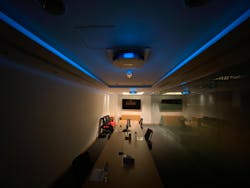Signify and Honeywell have announced a partnership focused on safer commercial buildings thanks to germicidal ultraviolet (UV) lighting and also a more pleasing and productive environment for workers in a space via human-centric lighting. Honeywell will integrate a number of Signify technologies into the Honeywell Building Management Systems suite. The first deployments of such integrated offerings are happening at OPTIMAX Eye Specialist clinics across Malaysia.
Apparently, there are three key segments of Signify’s lighting portfolio that will be closely connected to Honeywell smart building platforms. One will be solid-state lighting (SSL) products that target human-centric lighting or lighting for health and wellbeing. Such products will deliver a tunable spectrum that promises benefits ranging from improved productivity during the work day to better sleep patterns at night. The flagship Signify product in that category is NatureConnect. Signify announced that luminaire back in May and it mimics a skylight in terms of spectra, intensity, and spatial direction.
The second part of Signify’s portfolio that will be integrated in the partnership is a line of luminaires based on conventional UV-C-band (100–280-nm) lamps. The Signify lamps operate at around 254 nm, a wavelength near the peak of UV-C germicidal efficacy. Radiation at that wavelength can deactivate a pathogen such as the SARS-CoV-2 virus that causes COVID-19 almost instantaneously. Signify offers both UV-C products that can disinfect surfaces quickly when people are not present and also luminaires that mount near the ceiling to disinfect air continuously, which are safe to use in the presence of people because the luminaires control the beam in the upper volumetric space within a room. We recently covered a project at a German grocer using the upper-air products.
The third segment of the Signify portfolio that Honeywell will utilize is the Interact Internet of Things (IoT) platform. Signify rolled out Interact and the Interact Office variant more than two years ago at Light + Building (L+B). The platform can connect sensor and luminaire networks and slash energy use in buildings through programmatic and autonomous controls. Signify has even added an app to Interact during the pandemic that can analyze office traffic patterns and eliminate choke points that hamper social distancing protocols.
The Signify technologies will serve as a complement to Honeywell’s Healthy Buildings air-quality-focused products and will operate within the Honeywell Health Buildings control system or dashboard. “Increasingly, we see lighting systems playing a critical role in buildings to improve occupant comfort, wellbeing, and productivity as well as to help meet energy savings goals. We anticipate this trend will continue to grow,” said Vimal Kapur, president and CEO of Honeywell Building Technologies. “Our collaboration with Signify will allow us to enable our customers to implement integrated lighting solutions that help improve the occupant experience with customizable, personal lighting options that can be integrated into our Honeywell Forge and Building Management Systems platforms.”
Deployments that will test the partnership’s plans are happening, focused mostly on germicidal UV-C at the start. Honeywell is installing Signify UV-C lighting in many of its own buildings. And the aforementioned eye clinic chain is installing a variety of UV-C systems. “Honeywell and Signify offered our clinics a complete solution for air, surface, and object disinfection that allows us to clearly communicate to our clinicians, staff, and patients how we are working to support wellbeing in our spaces,” said Tan Sri Dato’ Tan Boon Hock, founder of OPTIMAX Eye Specialists Centre.
The joint announcement said the clinics were utilizing the upper-air disinfection units as well as dedicated UV-C trolleys. Note that such trolleys must be carefully deployed in spaces to ensure that people are not exposed to UV-C radiation as it can damage skin and eyes. Details on such safeguards were not included in the announcement.
We also asked a spokesperson about the use of UV-C inside air-circulation equipment. That spokesperson said in the current installations, there is no UV-C being deployed internal to HVAC systems, although we continue to believe that such installations will ultimately prove to be the most effective weapon against pathogens going forward. We are awaiting clarification, however, on the clinic installations because the announcement did say that UV-C was installed in “Honeywell controlled fan coil units.”
For up-to-the-minute LED and SSL updates, why not follow us on Twitter? You’ll find curated content and commentary, as well as information on industry events, webcasts, and surveys on our LinkedIn Company Page and our Facebook page.





